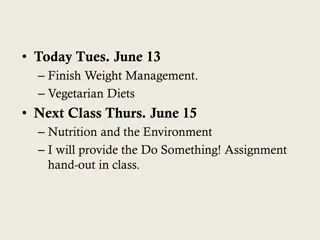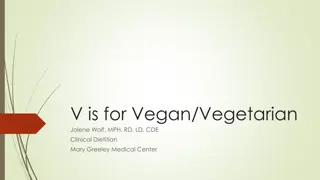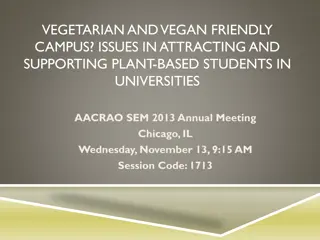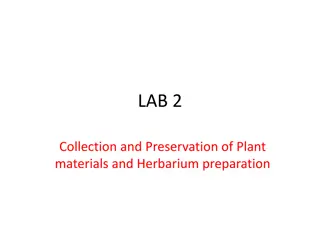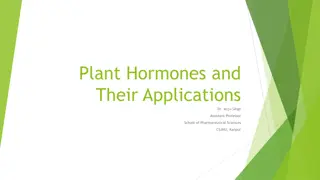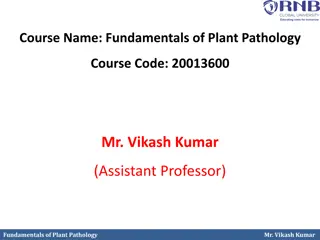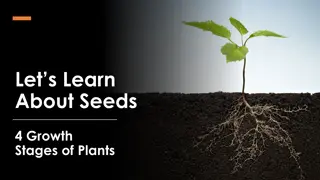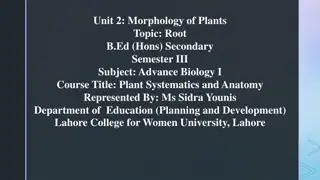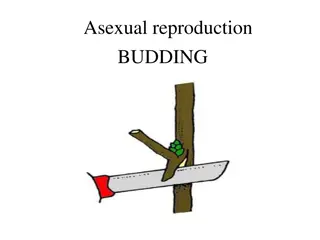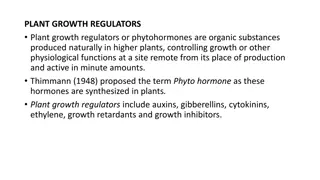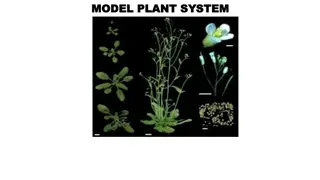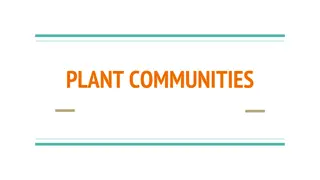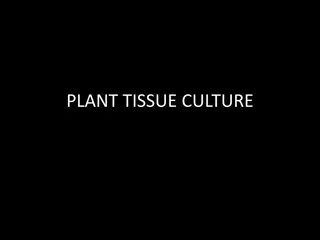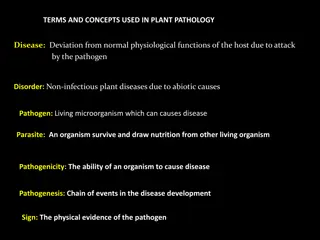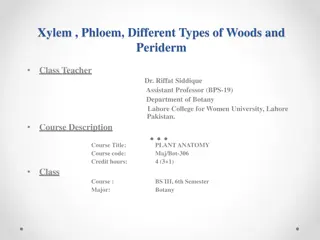Understanding Plant-Based Lifestyles: Vegetarian, Vegan, or Somewhere In Between
Exploring the history and different forms of plant-based lifestyles, this article delves into veganism and its impact on animals and the environment. It discusses various approaches like vegan, lactovegetarian, ovovegetarian, and ovolactovegetarian diets, highlighting their differences and benefits. The American Vegan Society's message of compassion and reverence for all living creatures encapsulates the essence of this lifestyle towards a more sustainable future.
Download Presentation

Please find below an Image/Link to download the presentation.
The content on the website is provided AS IS for your information and personal use only. It may not be sold, licensed, or shared on other websites without obtaining consent from the author. Download presentation by click this link. If you encounter any issues during the download, it is possible that the publisher has removed the file from their server.
E N D
Presentation Transcript
Plant-Based Lifestyles: Vegetarian, Vegan or Somewhere In Between Solar-Powered Food Can Help Save the Planet
A Little Backstory The term veganism, also known as strict or pure vegetarianism , was first established in 1944 by Donald Watson and represents the beginning and end of vegetarian . (Frey, Rebecca J. 1) Given by the Vegan Society, which was co-founded by Donald Watson and Erie Shrigley, veganism is defined as a philosophy and way of living which seeks to exclude-as far as is possible and practical-all forms of exploitation of, and cruelty to, animals for food clothing, or any other purpose. (Frey, Rebecca J. 1)
A Little Backstory When taking a look back throughout history, it is known that prehistoric humans were not vegan because of the way that their digestive tract mimicked that of omnivores. (Frey, Rebecca J. 2) Omnivores are animals whose teeth and digestive tract consumed either plant or animal matter. (Frey, Rebecca J. 7) Knowing this, the human stomach secretes pepsin which is an enzyme necessary for digesting the proteins found in meat rather than plant matter. (Frey, Rebecca J. 2) All of this means that the earliest motivation to keep a vegan lifestyle is mainly through religious faith and practice. (Frey, Rebecca J. 2)
About the Lifestyle There are a few ways to go about this lifestyle and each can be very effective in helping save animals and the environment if done correctly. Here are the different ways: VEGAN- a vegetarian who excludes all animal products from diet, including those that can be obtained without killing the animal. ((Frey, Rebecca J. 8) LACTOVEGETARIAN- a vegetarian who uses milk and cheese in addition to plant- based foods (Frey, Rebecca J. 7) OVOLACTOVEGETARIAN- a vegetarian who consumes eggs and dairy products as well as plant-based foods. (Frey, Rebecca J. 7) OVOVEGETARIAN- a vegetarian who eats eggs in addition to plant-based foods(Frey, Rebecca J. 7) What does this mean for food consumption? Well this means that vegans exclude all meat, dairy, fish, poultry and egg products from their diet. As for deriving their protein from sources like beans, tofu, soy products, nuts, seeds and whole grains. (Frey, Rebecca J. 1) Vegans also avoid using any kind of clothing, cosmetics or any other products for personal use that are made from animal products. (Frey, Rebecca J. 1)
About the Lifestyle A statement of the American Vegan Society (AVS), which was founded in 1960, gives a great message to those thinking of joining this lifestyle. It reads Veganism is compassion in action. It is a philosophy, diet and lifestyle. Veganism is an advanced way of living in accordance with Reverence of Life, recognizing the rights of all living creatures and extending them the compassion, kindness and justified in the Golden Rule. (Frey, Rebecca J. 3) The Golden Rule for those who do not know is Do unto others as you would have them do unto you.
Health Benefits One of the main benefits of taking up veganism, besides being the most sustainable diet in terms of the environment, is that plant-based diets are a form of preventative health care. This means that for people with an increased risk of diseases like type 2 diabetes, heart disease and even some forms of cancer that a plant-based diet could be the start to their journey in recovery. (Frey, Rebecca J. 5) Some other health benefits that go along with either a vegan diet or a not so strict vegetarian diet consist of lowered blood pressure and cholesterol levels, lower rates of cardiovascular disease and stroke, and even in some cases lowered the risk of colon and prostate cancer. (Frey, Rebecca J. 5) These diets can also cause weight loss and lower BMI as well. (Frey, Rebecca J. 3)
Overall Health When looking at the overall health of today s society it is easy to see that there are a growing number of concerns dealing with the raising and producing of meat products. One that is well-known is the creation and spread of antibiotic-resistant bacteria cause by the modern methods of raising animals. (McDermont, Matthew. 56) It is now because of the rise in antibiotic-resistant infections that the US Centers for Disease Control estimated that each year Americans incur at least 2 million antibiotic-resistant infections (McDermont, Matthew. 56) and these numbers will continue to rise without proper regulation in the industry. This threat is so serve that the United Nations has characterized it as a global crisis and only three other health issues have ever been the focus on high-level general assembly meetings: HIV, Ebola and noncommunicable diseases. (McDermont, Matthew. 56) Did you know that around the world more than half of all the antibiotics produced are given to farm animals and more than 80% of the USA s antibiotics are actually given to farm animals? (McDermont, Matthew. 56)
Some of the Resources Used Now it is time to get a look into how much it costs for the environment to produce there animal products. According to the USDA, the ratio of kilograms of grain to animal protein is: 0.7 kg of grain to 1 kg of milk 2.3 kg of grain to 1 kg of chicken 5.9 kg of grain to 1 kg of pork 11 kg of grain to 1 kg of eggs 13 kg of grain to 1 kg of beef 21 kg of grain to 1 kg of lamb ( In other words, it takes 21 kg of edible grain (or 20 kg of forage) to yield 1 edible kg of lamb and 13 kg of edible grain (or 30 kg of forage) for 1 kg of beef. ) (Henning, Brian. 68) Now taking a look at freshwater usage, there was a study conducted by National Geographic in 2010 that said it takes: 1,799 gallons of water to create 1 pound (0.5kg) of beef 576 gallons of water to create 1 (0.5kg) pound of pork 468 gallons of water to create 1 (0.5kg) pound of chicken 216 gallons of water for 1 (0.5kg) pound of soy beans (It was estimated that producing one kilogram of animal protein requires 100 times more water than producing one kilogram of grain protein) (Henning, Brian. 70)
Some of the Resources Used Another study revealed that to produce 1 kg of beef in a US feedlot requires the equivalent of 14.8 kg of CO2. Producing 1 kg of beef this has a similar impact on the environment as 6.2 gallons of gasoline, or driving 160 miles in the average American mid-sized car. (Henning, Brian. 74)
Precautions & Risks Remember though that is always wise to first talk to your physician in regards to any changes you might want to take on your diet because there can be risks associated in taking on this new lifestyle. When these diets are not handled appropriately nutritional deficiencies in protein, minerals(iron, calcium and zinc), vitamins(vitamin D, riboflavin, vitamin B12 and vitamin A), iodine and omega-3 fatty acids can result. (Frey, Rebecca J. 6) That why it is always recommended to seek out medical advice and go to a dietician first before starting any kind of diet that is different from your current one.
Precautions & Risks Also, some evidence suggests that these diets high in soy can increase the risk of breast cancer. This is due to the high amount of phytoestrogens, or plant estrogens, in soy products that have actually been implicated in breast cancer. (Frey, Rebecca J. 6)
Conclusion? If we can consciously consume what we need and when we need it, we might just be able to save this planet we live on for us and future generations.
Resources Bryngelsson, David, et al. How Do Dietary Choices Influence the Energy-System Cost of Stabilizing the Climate? Energies (19961073), vol. 10, no. 2, Feb. 2017, pp. 1 13. EBSCOhost, doi:10.3390/en10020182. Accessed Sept. 24, 2018 Frey, Rebecca J. "Veganism." The Gale Encyclopedia of Diets, edited by Kristin Key, Gale, 2nd edition, 2013. Credo Reference, https://search.credoreference.com/content/entry/galediets/veganism/0? institutionId=5312. Accessed 24 Sep. 2018. Henning, Brian. Standing in Livestock s Long Shadow : The Ethics of Eating Meat on a Small Planet. Ethics & the Environment, vol. 16, no. 2, Fall 2011, pp. 63 93. EBSCOhost, doi:10.2979/ethicsenviro.16.2.63. Accessed Sept. 24, 2018 McDermont, Matthew. Assessing the Meat Industry s Impact on Earth s Climate. Hinduism Today, vol. 39, no. 1, Jan. 2017, pp. 52 57. EBSCOhost, search.ebscohost.com/login.aspx?direct=true&db=a9h&AN=119815877&site=ehost-live. Accessed Sept. 24, 2018 Fox, Michael Allen. The Contribution of Vegetarianism to Ecosystem Health. Ecosystem Health, vol. 5, no. 2, June 1999, pp. 70 74. EBSCOhost, doi:10.1046/j.1526-0992.1999.09911.x. Accessed Sept. 24, 2018 Puka, Bill. The Golden Rule. The Internet Encyclopedia of Philosophy. https://www.iep.utm.edu/goldrule/
Image Resources All images to the background of the slides found on Google(except 2,3,10,11 and 12): http://www.xalazi.gr/perivallon/fysh/p/5790/fototropismos-gia-mia-thesi-ston-ilio https://blogs.biomedcentral.com/on-biology/2016/05/18/quiz-think-know-everything-plants/ https://www.health.com/nutrition/too-much-healthy-fat https://spaceplace.nasa.gov/stained-glass-earth/en/ SLIDE 1: https://www.vegansociety.com/ SLIDE 2: https://spectrumchart.blogspot.com/2017/01/chart-285-omnivorous-animals.html SLIDE 12: https://www.aspca.org/news/aspcas-2016-predictions-farm-animals


